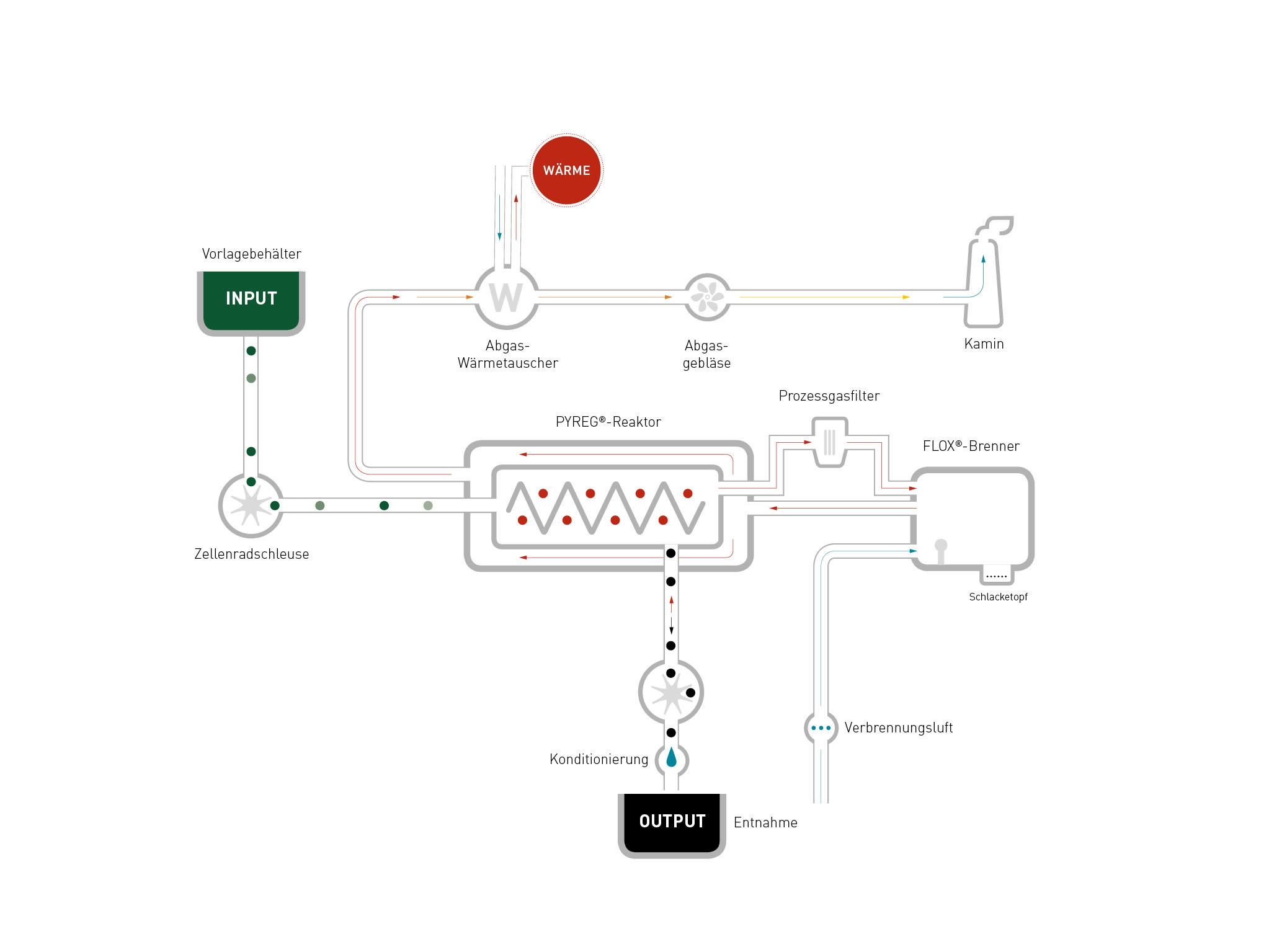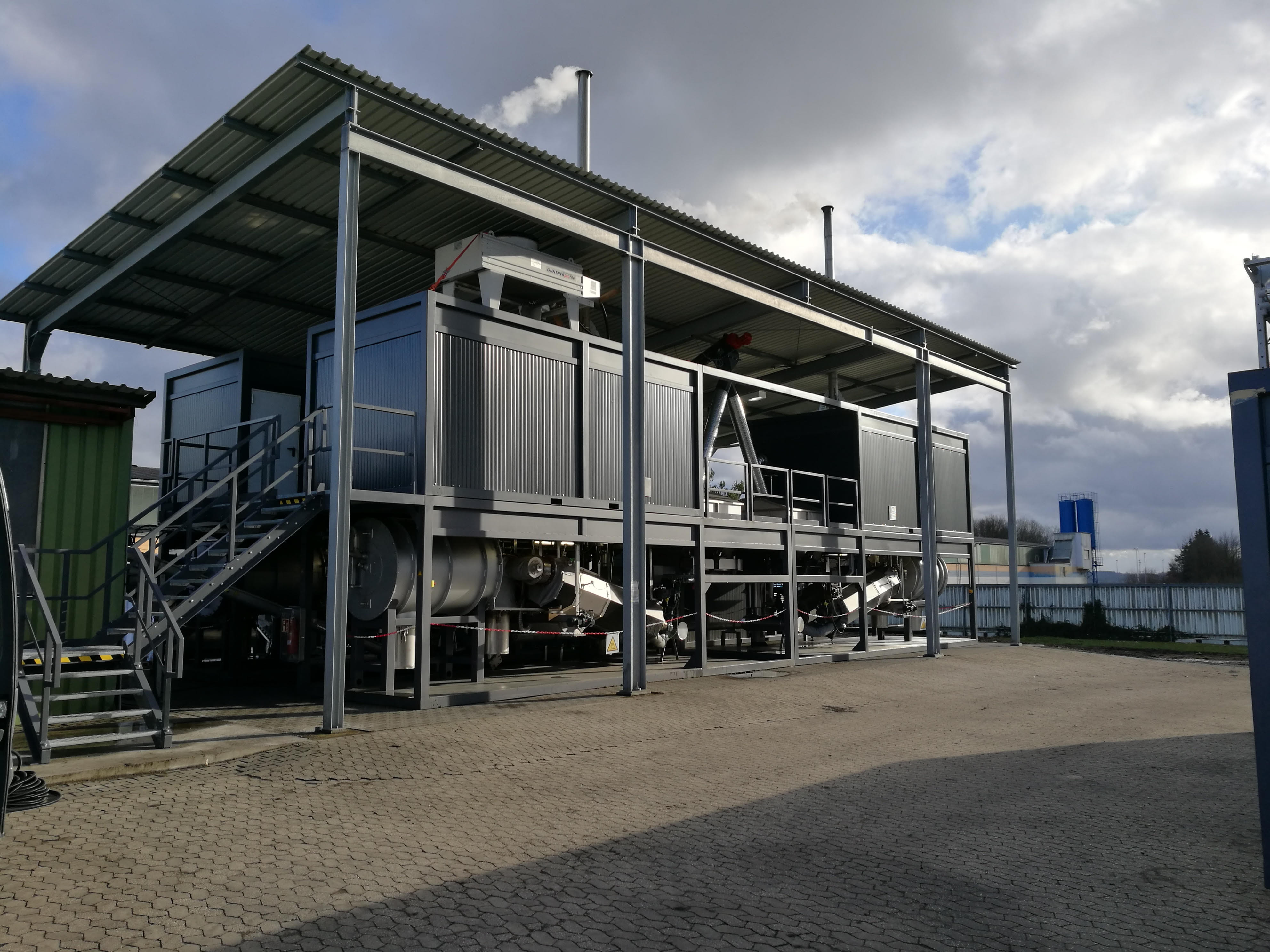Main navigation
NovoCarbo turns plant waste into biochar
NovoCarbo GmbH produces biochar from plant residues such as wood chips, nutshells and manure. Different feedstocks, and the way these materials are processed, create biochars with different properties. This makes biochar suitable for different uses, including as a soil conditioner, in biogas plants or as bedding for stables and cowsheds. The Rhizo-Linse project is currently investigating whether biochar is also suitable as inoculant carrier for lentil plant growth-promoting bacteria.

Biochar is made from plant residues that accumulate in agriculture, horticulture and viticulture or in municipalities. "Every year, we convert 3,000 tonnes of plant biomass into 700 tonnes of biochar," says Florian Lage, marketing and sales manager at NovoCarbo in Dörth, a town around hundred kilometres west of Frankfurt am Main. The company, founded in 2015, produces biochar using a process known as PYREG. This process involves breaking up the chemical compounds in the plant material at temperatures of 500 to 700 degrees Celsius. The process largely takes place in the absence of air, so that the material is charred rather than burned. This leads to gases that are combusted without hazardous by-products and produces stable ring-shaped carbon compounds known as biochar. Besides some external energy required to start the process, the PYREG process covers its own thermal energy requirements and even produces a surplus that is used by nearby companies or converted into electricity.
Biochars differ considerably depending on the feedstock and process parameters used; the PYREG process can lead to different types of biochar with different properties that are suitable for different applications. For example, biochars can differ in their carbon content, in the size and structure of their inner surface or in their pH. NovoCarbo's biochar is produced in accordance with European Biochar Certificate (EBC) standards, thus fulfilling the requirements of sustainable production and quality standards corresponding to certain applications. The voluntary certificate guarantees that the criteria for the biomass used are met; it further guarantees sustainable procurement and production of biomass feedstock, as well as compliance with biochar properties, biochar application and labelling.
Biochar improves soil
"90 percent of our biochar is used in agriculture, horticulture and landscaping," says Lage, "the majority of it is used as a soil conditioner." Biochar has a specific chemical structure, which means it can be "loaded" with nutrients. Biochar is porous and has a large internal surface area of 300 to 400 square metres per gramme; it can therefore store large amounts of water. The nutrients bind to so-called functional groups at the edge of the biochar, which are created when biochar reacts with oxygen from the air. In addition, the ash portion of biochar contains small amounts of nutrients. When biochar enters the soil, nutrients and water become available to plants and microorganisms. "Farmers usually have their own nutrients and therefore tend to buy "empty" biochars," Lage explains. Biochar can also be made to measure for clients such as horticultural companies and “loaded” with the required nutrients.

Numerous studies have demonstrated the positive effect of biochar as a soil conditioner: it promotes plant growth, increases microbial biomass, binds nutrients, reduces climate-damaging nitrous oxide emissions and keeps water in the soil. In addition, carbon is stored in the soil, which increases humus content in the long term. "3.5 tonnes of carbon dioxide are stored in one tonne of biochar. That is what I call active climate protection," says Lage, with some pride. He can be confident of what he is saying because biochar consists of very stable carbon compounds that are only broken down slowly. The carbon is therefore stored in biochar for a long time and is not released into the atmosphere as carbon dioxide, which is what happens when plant residues are burned or composted. The length of time that biochar is preserved in the soil depends on the feedstock used, pyrolysis temperature, climate and how the soil is used. In fact, biochar can remain in the soil for anything from a hundred to several thousand years. Man-made, biochar-based nutrient-rich soils in the Amazon Basin are characterised by the presence of decomposed organic matter and charcoal residues. Some of the soil thus created is over 7,000 years old.
In addition to soil conditioner, NovoCarbo also produces other types of biochar: used as a feed additive, biochar regulates digestion and increases feed efficiency. Used as stable bedding, biochar improves indoor climate and hygiene, as it absorbs moisture and nutrients and reduces ammonia and methane emissions, leading to fewer smells and fewer pathogens. The biochar thus becomes "loaded" with nutrients and populated with microorganisms, and can be applied directly to fields as a soil conditioner. In biogas plants, biochar is a habitat for bacteria, facilitating the stabilisation and increasing the performance of fermentation processes. The company is also involved in various research projects, as numerous other possible uses for biochar are conceivable, for example in building materials, plastics, textiles or for cleaning contaminated soils.
Applying inoculants with biochar
NovoCarbo is also involved in Rhizo-Linse, a project aimed at promoting the cultivation of lentils in Germany. Nadicom GmbH in Karlsruhe, the University of Hohenheim, the Agricultural Technology Center (LTZ) Augustenberg and BIOPRO Baden-Württemberg GmbH are also part of this project. Over the last few decades, fewer and fewer lentils and other protein crops have been grown. However, many consumers are now increasingly interested in local, sustainably produced foods.
The Rhizo-Linse project has two objectives: first, it seeks to identify new value chains for lentil cultivation as part of the bioeconomy: lentil plants are climbers that are grown with companion plants to help them stay upright. This reduces the risk of fungal diseases and makes harvesting easier. The second objective is to develop a lentil inoculant. This idea is based on the fact that lentils form symbiotic relationships with certain soil bacteria called rhizobia. These bind atmospheric nitrogen and convert it into nitrogen compounds that can be used by the plant. The inoculant consists of rhizobia strains that are especially effective in fixing nitrogen and is applied during sowing in such a way that each seed comes into contact with a bacterium. This provides the lentil plants with more nitrogen, the yields are higher and additional nitrogen fertilisation is not necessary.
This is where NovoCarbo comes in. The idea is to apply the inoculant with the help of biochar. "We are looking into which feedstock is best suited for the biochar we want to use for this purpose. The biochar needs to absorb the inoculant effectively and also needs to be processed well during sowing," says Lage. One potential advantage is that the bacteria could survive longer on the biochar. This is something that the researchers will also investigate. When asked why he chose to participate in the project, Lage said: "We found the project very exciting. Maybe it will bring about the cultivation of lentils once again." The Rhizo-Linse project began in March 2019 and will continue until early 2022. Funding of 655,500 euros is being provided by the European Agricultural Fund for Rural Development (EAFRD) and the Baden-Württemberg Ministry of Rural Affairs and Consumer Protection within the framework of the European Innovation Partnership for Agricultural Productivity and Sustainability (EIP-AGRI).
The project will run from March 2019 to early 2022 under the European Agricultural Productivity and Sustainability Innovation Partnership (EIP-AGRI). It will be given a total of €655,500 from the European Agricultural Fund for Rural Development (EAFRD) and the Baden-Württemberg Ministry of Rural Affairs, Food and Consumer Protection.
References:
Glaser, Bruno (2018) University of Halle-Wittenberg: Pflanzenkohle – Stand der Forschung. Vortrag auf Tagung CarboTip: www.geo.fu-berlin.de/geog/fachrichtungen/physgeog/geooekologie/medien/download/Vortraege_Workshop_CarboTIP_2018/7_Stand_Pflanzenkohleforschung_GLASER.pdf
Guidelines of the European Biochar Certification - Version 8.4 (as of 12th February 2020) www.european-biochar.org
German Federal Environment Agency (2016): Chancen und Risiken des Einsatzes von Biokohle und anderer "veränderter" Biomasse als Bodenhilfsstoffe oder für die C-Sequestrierung in Böden.